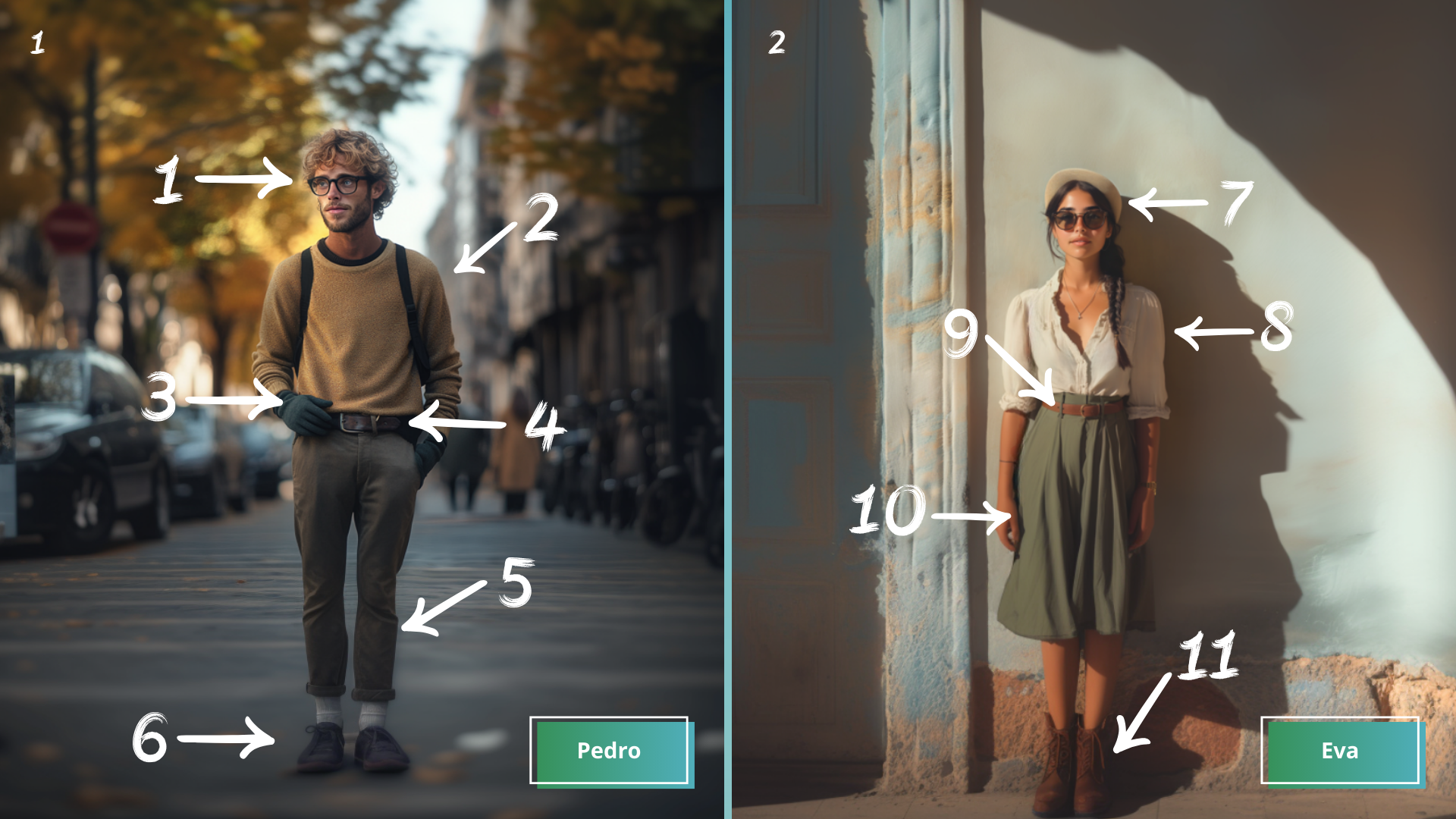Learn how to confidently ask for clothing sizes, request help, and describe clothes in Dutch at the clothing shop. This beginner (A1) lesson covers essential phrases, object pronouns, seasonal clothing vocabulary, helpful dialogues, and verb conjugations to support your shopping conversations.
Listening & reading materials
Practice vocabulary in context with real materials.
Vocabulary (19) Share Copied!
Exercises Share Copied!
These exercises can be done together during conversation lessons or as homework.
Exercise 1: Reorder sentences
Instruction: Make correct sentences and translate.
Exercise 2: Match a word
Instruction: Match the translations
Exercise 3: Cluster the words
Instruction: Divide the words into two groups: clothes you wear in warm weather and clothes you wear in cold weather.
Kleding voor warm weer
Kleding voor koud weer
Exercise 4: Translate and use in a sentence
Instruction: Pick a word, translated and use the word in a sentence or dialogue.
1
De broek
The trousers
2
De handschoenen
The gloves
3
Het pak
The suit
4
De kleding
The clothing
5
De jas
The jacket
Oefening 5: Conversation exercise
Instructie:
- Say who is wearing what. (Say who is wearing what. )
- What other clothing items do you know? (What other clothing items do you know?)
- Describe the clothes of the person next to you. (Describe the clothes of the person next to you.)
Teaching guidelines +/- 10 minutes
Example phrases:
|
Hij draagt handschoenen. He is wearing gloves. |
|
Zij draagt een riem. She is wearing a belt. |
|
Een ander kledingstuk dat ik ken is 'jurk'. As another clothing item I know "dress". |
|
Petra draagt een broek en een trui. Petra is wearing trousers and a jumper. |
|
Zij draagt laarzen. She is wearing boots. |
|
Mijn moeder draagt een bril. My mother is wearing glasses. |
|
Wat draag je vandaag? What are you wearing today? |
| ... |
Exercise 6: Dialogue Cards
Instruction: Select a situation and practice the conversation with your teacher or fellow students.
Exercise 7: Multiple Choice
Instruction: Choose the correct solution
1. Ik ___ de jas, maar hij zit te strak.
(I ___ the coat, but it is too tight.)2. ___ jij vaak een spijkerbroek naar je werk?
(___ you often wear jeans to work?)3. Wij ___ morgen onze nieuwe schoenen.
(We ___ will wear our new shoes tomorrow.)4. Kan ik deze jurk ___?
(Can I ___ this dress?)Exercise 8: In the clothing store
Instruction:
Verb Tables
Passen - To try on
Onvoltooid tegenwoordige tijd
- Ik pas
- Jij past
- Hij/Zij/Het past
- Wij passen
- Jullie passen
- Zij passen
Dragen - To wear
Onvoltooid tegenwoordige tijd
- Ik draag
- Jij draagt
- Hij/Zij/Het draagt
- Wij dragen
- Jullie dragen
- Zij dragen
Helpen - To help
Onvoltooid tegenwoordige tijd
- Ik help
- Jij helpt
- Hij/Zij/Het helpt
- Wij helpen
- Jullie helpen
- Zij helpen
Hebben - To have
Onvoltooid tegenwoordige tijd
- Ik heb
- Jij hebt
- Hij/Zij/Het heeft
- Wij hebben
- Jullie hebben
- Zij hebben
Proberen - To try on
Onvoltooid tegenwoordige tijd
- Ik probeer
- Jij probeert
- Hij/Zij/Het probeert
- Wij proberen
- Jullie proberen
- Zij proberen
Zitten - To fit
Onvoltooid tegenwoordige tijd
- Ik zit
- Jij zit
- Hij/Zij/Het zit
- Wij zitten
- Jullie zitten
- Zij zitten
Exercise 9: Persoonlijke voornaamwoorden: voorwerp (mij, jou, hem,...)
Instruction: Fill in the correct word.
Grammar: Personal pronouns: object (mij, jou, hem,...)
Show translation Show answersjou, hen, mij, hem, haar
Grammar Share Copied!
It's not the most exciting thing, we admit, but it’s absolutely essential (and we promise it'll pay off)!
A1.21.2 Grammatica
Persoonlijke voornaamwoorden: voorwerp (mij, jou, hem,...)
Personal pronouns: object (mij, jou, hem,...)
Verb conjugation tables for this lesson Share Copied!
Passen to try on Share Copied!
Onvoltooid tegenwoordige tijd (OTT)
| Dutch | English |
|---|---|
| (ik) pas | I try on |
| (jij) past/pas | you try on |
| (hij/zij/het) past | He/she/it tries on |
| (wij) passen | we try on |
| (jullie) passen | you try on |
| (zij) passen | they try on |
Dragen to wear Share Copied!
Onvoltooid tegenwoordige tijd (OTT)
| Dutch | English |
|---|---|
| (ik) draag | I wear |
| (jij) draagt/draag | you wear |
| (hij/zij/het) draagt | he/she/it wears |
| (wij) dragen | we wear |
| (jullie) dragen | you wear |
| (zij) dragen | they wear |
Don't see progress when learning on your own? Study this material with a certified teacher!
Do you want to practice Dutch today? That is possible! Just contact one of our teachers today.
Welcome to Your Dutch Shopping Lesson
This lesson focuses on everyday language you can use in a clothing store in the Netherlands. You will learn how to ask for advice, request sizes, describe clothing, and politely ask for help when shopping. The content is designed for beginners (A1 level), helping you to confidently communicate your needs when buying clothes.
Key Learning Areas
- Pronouns as objects: such as mij (me), jou (you), hem (him), which help you ask questions politely and clearly.
- Common phrases to ask about clothing: e.g., "Heeft u deze jas ook in mijn maat?" (Do you have this coat in my size?), or "Kan ik deze jurk passen?" (Can I try on this dress?).
- Clothing vocabulary sorted by season: warm-weather clothes like de jurk (dress), de bloes (blouse), and cold-weather clothes like de jas (coat), de trui (sweater).
- Dialogues for practical use: to practice asking about sizes, availability, and requesting assistance politely.
- Verb conjugations: verbs such as passen (to try on), dragen (to wear), and helpen (to help) in the present tense help express your actions clearly.
Study Tips and Notes
Note that in Dutch, personal object pronouns like mij and jou are often used in direct requests or questions, which may differ from English where sometimes subject pronouns or different constructions are used. For example, "Geef je mij de handschoenen daar?" translates to "Can you give me the gloves over there?" You will find this form very common and polite in Dutch everyday conversation.
This lesson helps you build useful phrases for shopping, including polite questions and clear requests to make your experience at Dutch stores smooth and enjoyable.





























